
Illustrative Math Alignment: Grade 7 Unit 9
Putting it All Together
Lesson 4: Restaurant Floor Plan
Use the following Media4Math resources with this Illustrative Math lesson.
| Thumbnail Image | Title | Body | Curriculum Topic |
|---|---|---|---|

|
Math Example--Fraction Properties--Fractions, Decimals, and Percents: Example 3 | Fractions, Decimals, and Percents: Example 3TopicFractions |
Relate Fractions to Decimals |
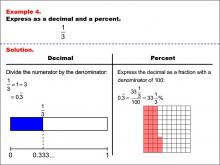
|
Math Example--Fraction Properties--Fractions, Decimals, and Percents: Example 4 | Fractions, Decimals, and Percents: Example 4TopicFractions |
Relate Fractions to Decimals |

|
Math Example--Fraction Properties--Fractions, Decimals, and Percents: Example 4 | Fractions, Decimals, and Percents: Example 4TopicFractions |
Relate Fractions to Decimals |

|
Math Example--Fraction Properties--Fractions, Decimals, and Percents: Example 4 | Fractions, Decimals, and Percents: Example 4TopicFractions |
Relate Fractions to Decimals |

|
Math Example--Fraction Properties--Fractions, Decimals, and Percents: Example 4 | Fractions, Decimals, and Percents: Example 4TopicFractions |
Relate Fractions to Decimals |

|
Math Example--Fraction Properties--Fractions, Decimals, and Percents: Example 4 | Fractions, Decimals, and Percents: Example 4TopicFractions |
Relate Fractions to Decimals |

|
Math Example--Fraction Properties--Fractions, Decimals, and Percents: Example 5 | Fractions, Decimals, and Percents: Example 5TopicFractions |
Relate Fractions to Decimals |

|
Math Example--Fraction Properties--Fractions, Decimals, and Percents: Example 5 | Fractions, Decimals, and Percents: Example 5TopicFractions |
Relate Fractions to Decimals |

|
Math Example--Fraction Properties--Fractions, Decimals, and Percents: Example 5 | Fractions, Decimals, and Percents: Example 5TopicFractions |
Relate Fractions to Decimals |

|
Math Example--Fraction Properties--Fractions, Decimals, and Percents: Example 5 | Fractions, Decimals, and Percents: Example 5TopicFractions |
Relate Fractions to Decimals |

|
Math Example--Fraction Properties--Fractions, Decimals, and Percents: Example 5 | Fractions, Decimals, and Percents: Example 5TopicFractions |
Relate Fractions to Decimals |
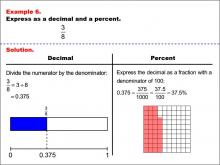
|
Math Example--Fraction Properties--Fractions, Decimals, and Percents: Example 6 | Fractions, Decimals, and Percents: Example 6TopicFractions |
Relate Fractions to Decimals |

|
Math Example--Fraction Properties--Fractions, Decimals, and Percents: Example 6 | Fractions, Decimals, and Percents: Example 6TopicFractions |
Relate Fractions to Decimals |

|
Math Example--Fraction Properties--Fractions, Decimals, and Percents: Example 6 | Fractions, Decimals, and Percents: Example 6TopicFractions |
Relate Fractions to Decimals |

|
Math Example--Fraction Properties--Fractions, Decimals, and Percents: Example 6 | Fractions, Decimals, and Percents: Example 6TopicFractions |
Relate Fractions to Decimals |

|
Math Example--Fraction Properties--Fractions, Decimals, and Percents: Example 6 | Fractions, Decimals, and Percents: Example 6TopicFractions |
Relate Fractions to Decimals |

|
Math Example--Fraction Properties--Fractions, Decimals, and Percents: Example 7 | Fractions, Decimals, and Percents: Example 7TopicFractions |
Relate Fractions to Decimals |

|
Math Example--Fraction Properties--Fractions, Decimals, and Percents: Example 7 | Fractions, Decimals, and Percents: Example 7TopicFractions |
Relate Fractions to Decimals |

|
Math Example--Fraction Properties--Fractions, Decimals, and Percents: Example 7 | Fractions, Decimals, and Percents: Example 7TopicFractions |
Relate Fractions to Decimals |

|
Math Example--Fraction Properties--Fractions, Decimals, and Percents: Example 7 | Fractions, Decimals, and Percents: Example 7TopicFractions |
Relate Fractions to Decimals |

|
Math Example--Fraction Properties--Fractions, Decimals, and Percents: Example 7 | Fractions, Decimals, and Percents: Example 7TopicFractions |
Relate Fractions to Decimals |
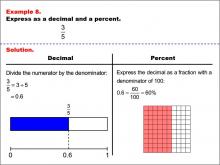
|
Math Example--Fraction Properties--Fractions, Decimals, and Percents: Example 8 | Fractions, Decimals, and Percents: Example 8TopicFractions |
Relate Fractions to Decimals |

|
Math Example--Fraction Properties--Fractions, Decimals, and Percents: Example 8 | Fractions, Decimals, and Percents: Example 8TopicFractions |
Relate Fractions to Decimals |

|
Math Example--Fraction Properties--Fractions, Decimals, and Percents: Example 8 | Fractions, Decimals, and Percents: Example 8TopicFractions |
Relate Fractions to Decimals |

|
Math Example--Fraction Properties--Fractions, Decimals, and Percents: Example 8 | Fractions, Decimals, and Percents: Example 8TopicFractions |
Relate Fractions to Decimals |

|
Math Example--Fraction Properties--Fractions, Decimals, and Percents: Example 8 | Fractions, Decimals, and Percents: Example 8TopicFractions |
Relate Fractions to Decimals |

|
Math Example--Fraction Properties--Fractions, Decimals, and Percents: Example 9 | Fractions, Decimals, and Percents: Example 9TopicFractions |
Relate Fractions to Decimals |

|
Math Example--Fraction Properties--Fractions, Decimals, and Percents: Example 9 | Fractions, Decimals, and Percents: Example 9TopicFractions |
Relate Fractions to Decimals |

|
Math Example--Fraction Properties--Fractions, Decimals, and Percents: Example 9 | Fractions, Decimals, and Percents: Example 9TopicFractions |
Relate Fractions to Decimals |

|
Math Example--Fraction Properties--Fractions, Decimals, and Percents: Example 9 | Fractions, Decimals, and Percents: Example 9TopicFractions |
Relate Fractions to Decimals |

|
Math Example--Fraction Properties--Fractions, Decimals, and Percents: Example 9 | Fractions, Decimals, and Percents: Example 9TopicFractions |
Relate Fractions to Decimals |

|
Math Example--Math of Money--Calculating Tax--Example 1 | Math Example--Math of Money--Calculating Tax--Example 1TopicThe Math of Money DescriptionWhat is the tax due on a $1000 purchase when the sales tax rate is 5%? The example shows how to apply the formula Tax Due = Cost * Tax Rate. Calculating tax is a fundamental skill in understanding financial literacy. This example and others like it help illustrate how percentages are applied in real-world scenarios, such as shopping and services. Seeing multiple worked-out examples allows students to recognize patterns and reinforce their understanding of applying formulas consistently in various contexts. It ensures they can adapt to different numbers and situations. |
Percents |

|
Math Example--Math of Money--Calculating Tax--Example 1 | Math Example--Math of Money--Calculating Tax--Example 1TopicThe Math of Money DescriptionWhat is the tax due on a $1000 purchase when the sales tax rate is 5%? The example shows how to apply the formula Tax Due = Cost * Tax Rate. Calculating tax is a fundamental skill in understanding financial literacy. This example and others like it help illustrate how percentages are applied in real-world scenarios, such as shopping and services. Seeing multiple worked-out examples allows students to recognize patterns and reinforce their understanding of applying formulas consistently in various contexts. It ensures they can adapt to different numbers and situations. |
Percents |

|
Math Example--Math of Money--Calculating Tax--Example 1 | Math Example--Math of Money--Calculating Tax--Example 1TopicThe Math of Money DescriptionWhat is the tax due on a $1000 purchase when the sales tax rate is 5%? The example shows how to apply the formula Tax Due = Cost * Tax Rate. Calculating tax is a fundamental skill in understanding financial literacy. This example and others like it help illustrate how percentages are applied in real-world scenarios, such as shopping and services. Seeing multiple worked-out examples allows students to recognize patterns and reinforce their understanding of applying formulas consistently in various contexts. It ensures they can adapt to different numbers and situations. |
Percents |

|
Math Example--Math of Money--Calculating Tax--Example 1 | Math Example--Math of Money--Calculating Tax--Example 1TopicThe Math of Money DescriptionWhat is the tax due on a $1000 purchase when the sales tax rate is 5%? The example shows how to apply the formula Tax Due = Cost * Tax Rate. Calculating tax is a fundamental skill in understanding financial literacy. This example and others like it help illustrate how percentages are applied in real-world scenarios, such as shopping and services. Seeing multiple worked-out examples allows students to recognize patterns and reinforce their understanding of applying formulas consistently in various contexts. It ensures they can adapt to different numbers and situations. |
Percents |
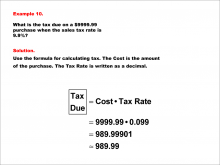
|
Math Example--Math of Money--Calculating Tax--Example 10 | Math Example--Math of Money--Calculating Tax--Example 10TopicThe Math of Money DescriptionWhat is the tax due on a $9999.99 purchase when the sales tax rate is 9.9%? The example shows how to apply the formula Tax Due = Cost * Tax Rate. Calculating tax is a fundamental skill in understanding financial literacy. This example and others like it help illustrate how percentages are applied in real-world scenarios, such as shopping and services. Seeing multiple worked-out examples allows students to recognize patterns and reinforce their understanding of applying formulas consistently in various contexts. It ensures they can adapt to different numbers and situations. |
Percents |

|
Math Example--Math of Money--Calculating Tax--Example 10 | Math Example--Math of Money--Calculating Tax--Example 10TopicThe Math of Money DescriptionWhat is the tax due on a $9999.99 purchase when the sales tax rate is 9.9%? The example shows how to apply the formula Tax Due = Cost * Tax Rate. Calculating tax is a fundamental skill in understanding financial literacy. This example and others like it help illustrate how percentages are applied in real-world scenarios, such as shopping and services. Seeing multiple worked-out examples allows students to recognize patterns and reinforce their understanding of applying formulas consistently in various contexts. It ensures they can adapt to different numbers and situations. |
Percents |

|
Math Example--Math of Money--Calculating Tax--Example 10 | Math Example--Math of Money--Calculating Tax--Example 10TopicThe Math of Money DescriptionWhat is the tax due on a $9999.99 purchase when the sales tax rate is 9.9%? The example shows how to apply the formula Tax Due = Cost * Tax Rate. Calculating tax is a fundamental skill in understanding financial literacy. This example and others like it help illustrate how percentages are applied in real-world scenarios, such as shopping and services. Seeing multiple worked-out examples allows students to recognize patterns and reinforce their understanding of applying formulas consistently in various contexts. It ensures they can adapt to different numbers and situations. |
Percents |

|
Math Example--Math of Money--Calculating Tax--Example 10 | Math Example--Math of Money--Calculating Tax--Example 10TopicThe Math of Money DescriptionWhat is the tax due on a $9999.99 purchase when the sales tax rate is 9.9%? The example shows how to apply the formula Tax Due = Cost * Tax Rate. Calculating tax is a fundamental skill in understanding financial literacy. This example and others like it help illustrate how percentages are applied in real-world scenarios, such as shopping and services. Seeing multiple worked-out examples allows students to recognize patterns and reinforce their understanding of applying formulas consistently in various contexts. It ensures they can adapt to different numbers and situations. |
Percents |
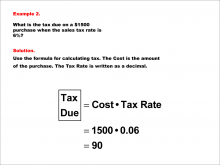
|
Math Example--Math of Money--Calculating Tax--Example 2 | Math Example--Math of Money--Calculating Tax--Example 2TopicThe Math of Money DescriptionWhat is the tax due on a $1500 purchase when the sales tax rate is 6%? The example shows how to apply the formula Tax Due = Cost * Tax Rate. Calculating tax is a fundamental skill in understanding financial literacy. This example and others like it help illustrate how percentages are applied in real-world scenarios, such as shopping and services. Seeing multiple worked-out examples allows students to recognize patterns and reinforce their understanding of applying formulas consistently in various contexts. It ensures they can adapt to different numbers and situations. |
Percents |

|
Math Example--Math of Money--Calculating Tax--Example 2 | Math Example--Math of Money--Calculating Tax--Example 2TopicThe Math of Money DescriptionWhat is the tax due on a $1500 purchase when the sales tax rate is 6%? The example shows how to apply the formula Tax Due = Cost * Tax Rate. Calculating tax is a fundamental skill in understanding financial literacy. This example and others like it help illustrate how percentages are applied in real-world scenarios, such as shopping and services. Seeing multiple worked-out examples allows students to recognize patterns and reinforce their understanding of applying formulas consistently in various contexts. It ensures they can adapt to different numbers and situations. |
Percents |

|
Math Example--Math of Money--Calculating Tax--Example 2 | Math Example--Math of Money--Calculating Tax--Example 2TopicThe Math of Money DescriptionWhat is the tax due on a $1500 purchase when the sales tax rate is 6%? The example shows how to apply the formula Tax Due = Cost * Tax Rate. Calculating tax is a fundamental skill in understanding financial literacy. This example and others like it help illustrate how percentages are applied in real-world scenarios, such as shopping and services. Seeing multiple worked-out examples allows students to recognize patterns and reinforce their understanding of applying formulas consistently in various contexts. It ensures they can adapt to different numbers and situations. |
Percents |

|
Math Example--Math of Money--Calculating Tax--Example 2 | Math Example--Math of Money--Calculating Tax--Example 2TopicThe Math of Money DescriptionWhat is the tax due on a $1500 purchase when the sales tax rate is 6%? The example shows how to apply the formula Tax Due = Cost * Tax Rate. Calculating tax is a fundamental skill in understanding financial literacy. This example and others like it help illustrate how percentages are applied in real-world scenarios, such as shopping and services. Seeing multiple worked-out examples allows students to recognize patterns and reinforce their understanding of applying formulas consistently in various contexts. It ensures they can adapt to different numbers and situations. |
Percents |
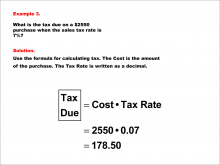
|
Math Example--Math of Money--Calculating Tax--Example 3 | Math Example--Math of Money--Calculating Tax--Example 3TopicThe Math of Money DescriptionWhat is the tax due on a $2550 purchase when the sales tax rate is 7%? The example shows how to apply the formula Tax Due = Cost * Tax Rate. Calculating tax is a fundamental skill in understanding financial literacy. This example and others like it help illustrate how percentages are applied in real-world scenarios, such as shopping and services. Seeing multiple worked-out examples allows students to recognize patterns and reinforce their understanding of applying formulas consistently in various contexts. It ensures they can adapt to different numbers and situations. |
Percents |

|
Math Example--Math of Money--Calculating Tax--Example 3 | Math Example--Math of Money--Calculating Tax--Example 3TopicThe Math of Money DescriptionWhat is the tax due on a $2550 purchase when the sales tax rate is 7%? The example shows how to apply the formula Tax Due = Cost * Tax Rate. Calculating tax is a fundamental skill in understanding financial literacy. This example and others like it help illustrate how percentages are applied in real-world scenarios, such as shopping and services. Seeing multiple worked-out examples allows students to recognize patterns and reinforce their understanding of applying formulas consistently in various contexts. It ensures they can adapt to different numbers and situations. |
Percents |

|
Math Example--Math of Money--Calculating Tax--Example 3 | Math Example--Math of Money--Calculating Tax--Example 3TopicThe Math of Money DescriptionWhat is the tax due on a $2550 purchase when the sales tax rate is 7%? The example shows how to apply the formula Tax Due = Cost * Tax Rate. Calculating tax is a fundamental skill in understanding financial literacy. This example and others like it help illustrate how percentages are applied in real-world scenarios, such as shopping and services. Seeing multiple worked-out examples allows students to recognize patterns and reinforce their understanding of applying formulas consistently in various contexts. It ensures they can adapt to different numbers and situations. |
Percents |

|
Math Example--Math of Money--Calculating Tax--Example 3 | Math Example--Math of Money--Calculating Tax--Example 3TopicThe Math of Money DescriptionWhat is the tax due on a $2550 purchase when the sales tax rate is 7%? The example shows how to apply the formula Tax Due = Cost * Tax Rate. Calculating tax is a fundamental skill in understanding financial literacy. This example and others like it help illustrate how percentages are applied in real-world scenarios, such as shopping and services. Seeing multiple worked-out examples allows students to recognize patterns and reinforce their understanding of applying formulas consistently in various contexts. It ensures they can adapt to different numbers and situations. |
Percents |
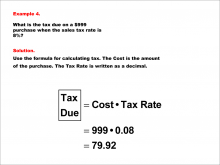
|
Math Example--Math of Money--Calculating Tax--Example 4 | Math Example--Math of Money--Calculating Tax--Example 4TopicThe Math of Money DescriptionWhat is the tax due on a $999 purchase when the sales tax rate is 8%? The example shows how to apply the formula Tax Due = Cost * Tax Rate. Calculating tax is a fundamental skill in understanding financial literacy. This example and others like it help illustrate how percentages are applied in real-world scenarios, such as shopping and services. Seeing multiple worked-out examples allows students to recognize patterns and reinforce their understanding of applying formulas consistently in various contexts. It ensures they can adapt to different numbers and situations. |
Percents |

|
Math Example--Math of Money--Calculating Tax--Example 4 | Math Example--Math of Money--Calculating Tax--Example 4TopicThe Math of Money DescriptionWhat is the tax due on a $999 purchase when the sales tax rate is 8%? The example shows how to apply the formula Tax Due = Cost * Tax Rate. Calculating tax is a fundamental skill in understanding financial literacy. This example and others like it help illustrate how percentages are applied in real-world scenarios, such as shopping and services. Seeing multiple worked-out examples allows students to recognize patterns and reinforce their understanding of applying formulas consistently in various contexts. It ensures they can adapt to different numbers and situations. |
Percents |

|
Math Example--Math of Money--Calculating Tax--Example 4 | Math Example--Math of Money--Calculating Tax--Example 4TopicThe Math of Money DescriptionWhat is the tax due on a $999 purchase when the sales tax rate is 8%? The example shows how to apply the formula Tax Due = Cost * Tax Rate. Calculating tax is a fundamental skill in understanding financial literacy. This example and others like it help illustrate how percentages are applied in real-world scenarios, such as shopping and services. Seeing multiple worked-out examples allows students to recognize patterns and reinforce their understanding of applying formulas consistently in various contexts. It ensures they can adapt to different numbers and situations. |
Percents |